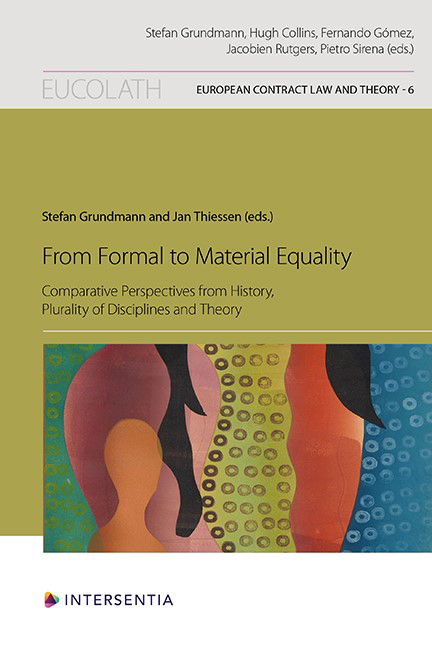 From Formal to Material Equality
From Formal to Material Equality Book contents
- Frontmatter
- Contents
- List of Authors
- From Formal to Material Equality: Key Insights from History and in a Multidisciplinary Perspective
- The Same Human Nature: Some Approaches to Equality in Law
- Two Centuries of Private Law Theory on Formal and Material Equality
- Equal Dignity of Human Beings: The Philosophical and Methodological Foundations of Private Law
- Equality Between Efficiency and Distribution: A Law and Economics Reconceptualisation of a Principle of Justice
- Dimensions of Equality in Private Law: Translating between Law, Society and Technology
- Index
- European Contract Law and Theory Series
The Same Human Nature: Some Approaches to Equality in Law
Published online by Cambridge University Press: 15 November 2023
- Frontmatter
- Contents
- List of Authors
- From Formal to Material Equality: Key Insights from History and in a Multidisciplinary Perspective
- The Same Human Nature: Some Approaches to Equality in Law
- Two Centuries of Private Law Theory on Formal and Material Equality
- Equal Dignity of Human Beings: The Philosophical and Methodological Foundations of Private Law
- Equality Between Efficiency and Distribution: A Law and Economics Reconceptualisation of a Principle of Justice
- Dimensions of Equality in Private Law: Translating between Law, Society and Technology
- Index
- European Contract Law and Theory Series
Summary
DIFFERENT APPROACHES TO EQUALITY IN LAW
EQUALITY AS A QUESTION OF JUSTICE – FIRST APPROACH
When thinking about “equality”, one almost inevitably falls into the footsteps of Aristotle, who distinguished between similarity – related to a quality – and equality, related to a quantity. Equality, in turn, was a central concept for his doctrine of justice, especially for his conception of an arithmetical equality in the iustitia commutativa.
However, I am more interested here in equality of status, which, following Aristotle ‘ s systematics, should rather be placed with iustitia distributiva, if not with justice in the general sense. However, Aristotle did not accept equality of status.
1.2. A HOPEFUL ENCOUNTER – SECOND APPROACH
Th e greatest conceivable legal inequality manifests itself in slavery. Th ere, the legal personhood of individuals, or a group of people, is simply denied and the person is degraded to a mere thing: the human being is legally degenerated to the status of a thing. The problem of justice that lies therein concerns the unequal treatment of members of the human species who are actually equally qualified. In antiquity, especially in Christianity, people were already sensitive to this, without, of course, drawing any legal conclusions from it. The letter of the apostle Paul to Philemon speaks of Onesimus, a (perhaps runaway) house slave. Paul sends him back to his master, the addressee of the letter. But Onesimus comes back to Philemon as a brother because of baptism, Paul writes:
I am appealing to you for a child of mine, whose father I became while wearing these chains: I mean Onesimus. … I am sending him back to you – that is to say, sending you my own heart. … I suppose you have been deprived of Onesimus for a time, merely so that you could have him back for ever, no longer as a slave, but something much better than a slave, a dear brother; especially dear to me, but how much more to you, both on the natural plane and in the Lord.
- Type
- Chapter
- Information
- From Formal to Material EqualityComparative Perspectives from History, Plurality of Disciplines and Theory, pp. 29 - 62Publisher: IntersentiaPrint publication year: 2023
